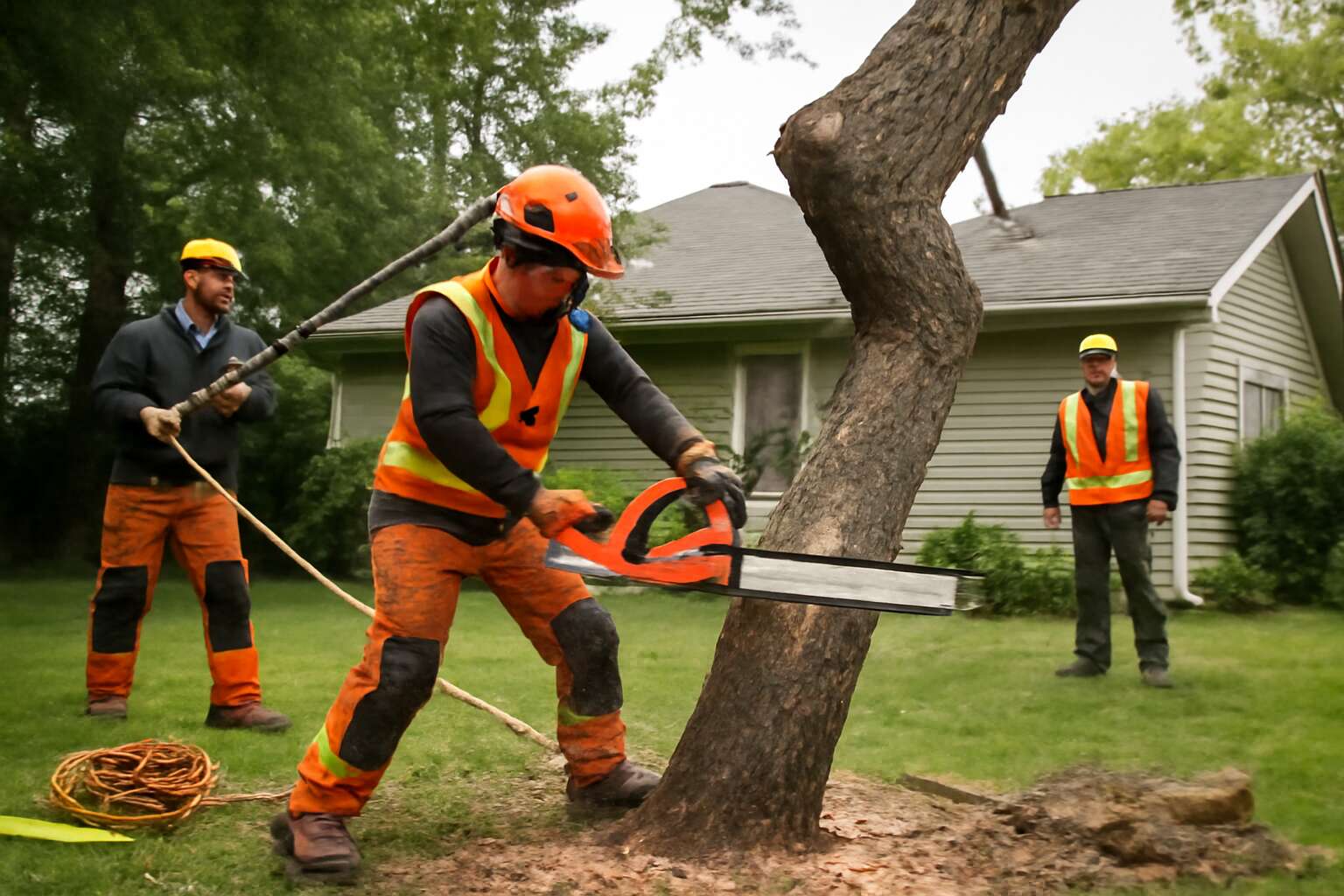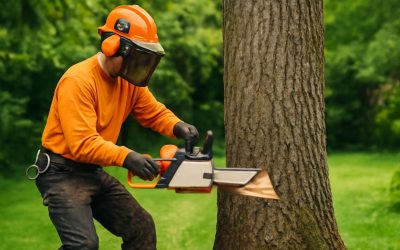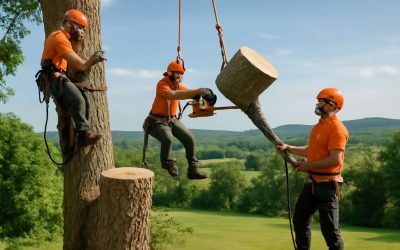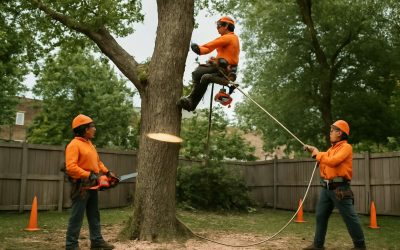Understanding Tree Removal and Insurance
The Importance of Proper Tree Removal – Why professional tree removal is essential for safety and property preservation
Tree removal without insurance might seem like a quick fix to save costs, but it’s a gamble that can backfire spectacularly. In South Africa, where unpredictable weather can turn a seemingly minor branch into a dangerous projectile, understanding the importance of proper tree removal is critical. Without the safety net of insurance, you bear the full brunt of any mishaps—damaged property, personal injury, or legal liabilities.
Professional tree removal isn’t just about cutting down a tree; it’s about ensuring the safety of everyone involved and safeguarding your property. Skilled arborists use specialized equipment and techniques to minimize risk, especially when dealing with large or unstable trees. Attempting a DIY removal or hiring unqualified workers increases the likelihood of accidents, which could cost far more than any insurance premiums. Remember, proper tree removal is an investment in peace of mind—something no amount of savings on insurance can replace.
Role of Insurance in Tree Removal Services – How insurance coverage typically protects homeowners and contractors
Understanding tree removal and insurance is crucial when considering the safety and security of your property. Tree removal without insurance might seem like a straightforward way to cut costs, but it leaves homeowners and contractors vulnerable to unexpected expenses. Insurance coverage in tree removal services acts as a safety net, protecting against the costly consequences of accidents or damage during the process.
Typically, insurance policies for tree removal include protection for both the homeowner and the contractor. This coverage ensures that if a tree falls unexpectedly or if equipment causes damage, the financial burden doesn’t fall solely on your shoulders. Without insurance, any mishap—be it property damage or personal injury—can become a legal and financial nightmare.
In South Africa, where weather conditions can swiftly turn a seemingly stable tree into a hazard, relying on insured professionals makes all the difference. When engaging with tree removal services, always verify that they have the necessary insurance—this simple step could save you from a world of trouble should an accident occur.
Common Reasons People Consider Tree Removal Without Insurance – Financial constraints, urgent situations, or lack of awareness
Understanding tree removal and insurance reveals a complex intersection of necessity, risk, and human vulnerability. For many homeowners faced with an imminent danger, the decision to opt for tree removal without insurance seems straightforward—save a few rand, resolve an urgent issue, or simply because awareness of insurance coverage is lacking. Yet, beneath this apparent simplicity lies a labyrinth of potential peril.
Financial constraints often drive people to consider tree removal without insurance. When budgets tighten, the allure of cheaper, uninsured services can be tempting, especially in urgent situations where immediate action feels like the only option. But this impulsive choice neglects the unpredictable nature of tree removal—where accidents can escalate into costly disasters in an instant.
In some cases, individuals may not fully grasp the importance of insurance or underestimate the risks involved. They might think that a straightforward removal will proceed smoothly, without the need for coverage. However, nature’s unpredictability—particularly in South Africa’s volatile weather—can turn a seemingly safe task into a legal and financial quagmire. Tree removal without insurance leaves homeowners exposed to unforeseen costs, from property damage to personal injury claims. The allure of quick savings can obscure the profound importance of protection—because when tragedy strikes, the true cost is often measured in more than just money.
Risks and Challenges of Tree Removal Without Insurance
Potential for Property Damage – Risks of unplanned damage to structures, vehicles, and landscaping
Opting for tree removal without insurance might seem like a quick fix for saving costs, but the risks are significant—especially when it comes to potential property damage. Without proper coverage, homeowners are left unprotected against the unpredictable consequences of an ill-timed or poorly executed tree removal. A falling branch or an unstable tree can cause damage to structures, vehicles, or landscaping, leading to hefty repair bills that no one wants to face alone.
When a tree falls unexpectedly, the financial burden often shifts to the property owner if there’s no insurance in place. The challenge becomes even greater in South Africa, where unpredictable weather and aging trees increase the chances of accidents. It’s crucial to understand that unplanned damage can escalate quickly, resulting in legal liabilities or costly repairs. Indeed, the risks of unplanned property damage make tree removal without insurance a gamble that often costs more than it saves.
Liability and Personal Financial Risk – Legal and financial liabilities arising from accidents or damage
Tree removal without insurance exposes property owners to serious legal and financial risks. If an accident occurs during unplanned or improper tree removal, liability can quickly spiral out of control. Without insurance, you are personally responsible for any damages or injuries caused by falling branches or unstable trees. This can mean facing hefty legal claims or compensation demands that threaten your financial stability.
In South Africa, where unpredictable weather can turn a seemingly minor issue into a major catastrophe, the stakes are even higher. A falling tree or branch can damage your home, vehicle, or neighboring property—costs that can easily run into tens of thousands of rands. When no insurance is in place, these costs fall squarely on your shoulders, often leading to devastating debt or legal action.
Furthermore, engaging in tree removal without insurance can lead to significant personal liability. Here’s a quick look at the challenges:
- Financial burden from unexpected property damage or injuries.
- Legal liabilities if third parties are harmed or property is damaged.
- Potential lawsuits that can take years to resolve, draining resources and peace of mind.
Choosing to proceed without insurance might seem like a cost-saving move, but the reality is that the risks far outweigh the short-term savings. When it comes to tree removal, the financial and legal risks can quickly escalate, leaving property owners exposed to unpredictable and often overwhelming consequences.
Safety Concerns for Homeowners and Neighbors – Increased risk of injury without proper coverage
Tree removal without insurance transforms a straightforward task into a perilous gamble with human lives and property. Without proper coverage, the risk of injury to homeowners, neighbors, or passersby skyrockets. Trees are unpredictable entities—what seems stable today may become a deadly hazard tomorrow. When an accident occurs during unplanned or improper tree removal, the consequences can be catastrophic, often leaving property owners exposed to severe legal and financial liabilities.
In South Africa, where the weather’s caprice can swiftly turn minor incidents into major disasters, the danger is even more pronounced. Falling branches or unstable trees can devastate homes, vehicles, or neighboring properties—costs that are difficult to bear without insurance. The challenge lies not only in the physical risk but also in the moral weight of potential harm caused by neglecting proper safety measures. Engaging in tree removal without insurance exposes you to a heightened risk of injury, which, without the safety net of coverage, can lead to devastating personal and financial consequences.
- The unanticipated injury or death of an individual due to falling debris.
- Damage to neighboring properties, often resulting in costly legal disputes.
- Long-term emotional and financial tolls that come with accidents that could have been prevented with proper coverage.
Safety concerns are not merely about avoiding legal repercussions—they strike at the core of human responsibility. When a tree’s weight shifts unexpectedly during removal, it’s not just a matter of property damage; lives hang in the balance. Tree removal without insurance increases the likelihood of accidents, and with no safety net, the aftermath can be devastating. It’s a stark reminder that neglecting insurance is a gamble, one that often costs more than the immediate expense of professional, insured services.
Legal and Regulatory Aspects of Tree Removal
Local Regulations and Permits – Understanding municipal requirements for tree removal
In the realm of tree removal without insurance, understanding the labyrinth of local regulations can be as vital as knowing the roots of the oldest baobab. Municipal authorities across South Africa often impose strict requirements to ensure that tree removal activities do not compromise public safety or environmental integrity. Without proper knowledge of these laws, homeowners risk unwelcome encounters with legal repercussions, hefty fines, or even court summons.
Most local governments mandate permits for tree removal, especially when dealing with protected species or trees located within conservation zones. Failing to secure these permits before any cut is made can turn an otherwise straightforward task into a costly ordeal. It’s essential to familiarize oneself with the specific municipal regulations governing tree removal, which might include:
- Applying for a removal permit from local authorities
- Complying with preservation orders for certain tree species
- Providing evidence of proper disposal or replanting plans
In South Africa, these regulations aim to balance urban development with the preservation of natural landscapes. Ignorance of these rules—especially when considering tree removal without insurance—can expose homeowners to legal liabilities and financial burdens that far outweigh the cost of professional, insured services. Remember: every tree has a story, and its removal must be handled with respect for the law, nature, and community safety.
Liability Laws and Responsibilities – Legal obligations of property owners and contractors
In the intricate dance of urban life, property owners bear a profound legal obligation to ensure that tree removal activities are conducted within the bounds of the law. When contemplating tree removal without insurance, understanding the liability laws that govern these actions becomes paramount. South African legislation mandates that property owners and contractors alike are responsible for any damage or injury resulting from their work, whether or not insurance is involved.
Failure to adhere to these regulatory obligations can lead to significant legal repercussions. Without the safety net of insurance, property owners risk facing personal financial liabilities if accidents occur or if damage extends beyond the boundaries of their property. Municipal authorities often enforce strict compliance, and non-adherence may result in hefty fines or court proceedings. It’s crucial to recognize that every act of tree removal, especially without insurance, carries with it a weight of responsibility that extends beyond mere legality—it touches on community safety and environmental stewardship.
Consequences of Non-Compliance – Fines, penalties, and legal action
Operating without insurance when undertaking tree removal without insurance can have serious legal repercussions. South African municipal authorities are strict about compliance, and failure to adhere to local regulations can lead to substantial fines or even court action. Authorities view unpermitted or uninsured tree removal as a breach of environmental and safety laws, risking community safety and environmental health.
Consequences of non-compliance are not merely financial; they can also tarnish reputations and lead to lengthy legal battles. Penalties may include:
- Hefty fines imposed by municipal authorities
- Court orders to cease work or rectify damages
- Liability for damages caused to neighbouring properties or infrastructure
In the absence of insurance, property owners are personally responsible for covering damages or injuries resulting from their actions. This responsibility extends beyond the legal obligation—it’s about accountability for community safety and environmental stewardship. Ignoring these regulations when considering tree removal without insurance is a gamble that can backfire financially and ethically.
Cost Considerations of Tree Removal Without Insurance
Typical Costs of Professional Tree Removal – Average pricing for insured services
Opting for tree removal without insurance might seem like a quick fix to save a few rand, but it’s a gamble that could cost you dearly—literally. The average cost for professional tree removal with insurance typically falls between R2,500 and R8,000 per tree, depending on size and location. But when insurance is absent, those numbers can skyrocket if something goes awry. Without coverage, you’re on the hook for any property damage, injuries, or legal liabilities that arise during the removal process.
In South Africa, the expense of unprotected tree removal can escalate rapidly—think broken fences, damaged cars, or even a legal battle with a neighbor. If you’re considering tree removal without insurance, it’s crucial to understand the potential financial pitfalls. The absence of insurance means you bear the full brunt of unforeseen mishaps, turning a seemingly simple task into a costly disaster. So, whether your budget is tight or you’re rushing to clear a hazard, remember that the true price of skipping insurance could be paid in more ways than one.
Hidden and Unexpected Expenses – Additional costs from property damage or injuries
Embarking on tree removal without insurance might seem like a straightforward way to cut costs, but the hidden expenses often outweigh the initial savings. When accidents happen—be it property damage or personal injuries—the financial burden quickly spirals beyond what most homeowners anticipate. Unexpected costs, such as repairing a broken fence or paying for medical bills, can easily escalate into thousands of rand. These unforeseen expenses underscore the peril of neglecting proper coverage for tree removal without insurance.
In South Africa, the true cost of unprotected tree removal becomes painfully apparent when mishaps occur. Damage to vehicles, neighboring properties, or underground utilities can turn an urgent removal into a legal nightmare. Without insurance, property owners are left to shoulder the full weight of liability, risking hefty fines or legal claims. The absence of coverage leaves you vulnerable, transforming what should be a routine task into a costly ordeal.
Financial Risks of DIY or Uninsured Removal – Cost analysis of handling tree removal independently
Opting for tree removal without insurance might seem like a savvy financial move at first glance—after all, who wants to fork out extra for coverage? But here’s the twist: the true cost of going the DIY or uninsured route can be astronomical. When a fallen branch crushes your fence or worse, injures a passerby, the expenses skyrocket faster than a tree in a hurricane. The financial risks of tree removal without insurance are not just hypothetical; they are painfully real, turning what seemed like a bargain into a full-blown budget blowout.
Without proper coverage, property owners are left holding the bill for damage to vehicles, underground utilities, or neighboring properties. The expense of repairs and legal liabilities can easily surpass what you’d pay for professional services with insurance. For instance, consider this: the average cost of professional tree removal in South Africa, complete with insurance, is often a fraction of what it costs to fix a damaged water line or cover medical bills—expenses that can quickly spiral into tens of thousands of rand. Trying to handle tree removal independently or without insurance might save you a few rand upfront, but the potential for unforeseen costs makes it a gamble that’s rarely worth the risk.
In the end, the true cost considerations of tree removal without insurance reveal a stark reality: it’s not just about the initial price tag. It’s about protecting yourself from the unpredictable chaos that can unfold when accidents happen. Skimping on insurance turns what should be a straightforward task into a financial minefield, where one misstep can leave you scrambling to cover the fallout. Because when it comes to tree removal, the only thing more expensive than paying for proper insurance is paying the price for not having it at all.
Alternatives to Tree Removal Without Insurance
Seeking Out Low-Cost or No-Interest Payment Options – Financing choices for insured services
When facing the daunting prospect of tree removal without insurance, exploring alternative financing options can make a significant difference. Many homeowners feel overwhelmed by the potential costs and worry about the financial strain. Fortunately, some service providers offer low-cost or no-interest payment plans, making essential tree removal more accessible. These flexible financing choices for insured services can sometimes be extended to those who cannot afford upfront payments, easing the burden without compromising safety or quality.
While it might seem tempting to handle tree removal without insurance, the risks often outweigh the savings. However, if you find yourself in a bind, look for companies that provide payment options such as:
- Deferred payment plans
- Zero-interest financing
- Monthly installment arrangements
Such options allow homeowners to spread the cost over time, reducing immediate financial pressure. Remember, opting for tree removal without insurance could expose you to unforeseen expenses—so carefully weighing these alternatives is often a smarter choice in the long run.
Finding Reputable, Insured Tree Removal Providers – How to verify and select trustworthy contractors
Finding reputable, insured tree removal providers is crucial when safeguarding your property and peace of mind. The wilderness of South Africa’s landscapes offers many contractors, but not all are equal in professionalism or liability coverage. To verify the credibility of a contractor, always request proof of insurance—this is your safety net against unforeseen mishaps. A trustworthy company will gladly provide documentation that confirms they possess comprehensive liability and worker’s compensation insurance, protecting you from personal financial risk.
When selecting a contractor for tree removal without insurance, it’s essential to do your due diligence. Start by checking online reviews, seeking recommendations from neighbors, and confirming licensing credentials. An experienced, insured provider will prioritize safety and adhere to local regulations—ensuring that your tree removal project is handled responsibly and legally. Remember, the lowest quote might come with hidden risks, making verification an indispensable step in choosing your tree removal partner.
DIY Tree Removal with Proper Safety Measures – When and how to safely remove a tree without professional help
Sometimes, urgent circumstances or tight budgets lead homeowners to consider tree removal without insurance. While it might seem like a quick fix, this approach carries significant risks. Removing a tree without insurance means you’re on your own if accidents happen. Property damage, injury, or legal liabilities can quickly turn into costly nightmares. Without proper safety measures, you might damage nearby structures or even face personal injury. It’s crucial to weigh these dangers before proceeding.
If you decide to go ahead with DIY tree removal, safety must be your top priority. Use the right equipment—chainsaws, ropes, and safety gear—and ensure you understand the tree’s structure. It’s best to work with a partner and keep a clear escape route. Remember, even small miscalculations can lead to big consequences. For those with some experience, trimming or removing smaller trees under controlled conditions might be feasible, but larger trees are best left to professionals—even if that means risking a higher cost for insured services. Safety always comes first!
Ultimately, while tree removal without insurance might seem like a way to save money, the hidden costs and risks often outweigh the initial savings. Proper planning, adherence to local regulations, and understanding your limits are essential. When in doubt, consult with experts who carry comprehensive liability coverage—your peace of mind is worth it.
Tips for Protecting Yourself When Considering Uninsured Tree Removal
Assessing the Tree’s Condition and Potential Risks – Signs of danger and when to avoid DIY removal
When contemplating tree removal without insurance, understanding the tree’s condition becomes paramount. A seemingly healthy tree can harbor internal decay or structural weaknesses that are invisible to the naked eye—risks that escalate dramatically during removal. To safeguard yourself, meticulously assess signs of danger such as cracking bark, dead branches, or leaning trunk, which may indicate imminent failure. Recognizing these warning signs can mean the difference between a controlled process and a catastrophic accident.
In situations where the risk of injury or property damage is high, DIY removal should be avoided at all costs. The unpredictability of falling branches or the sudden collapse of compromised limbs poses serious safety concerns for homeowners and neighbors alike. If the tree exhibits signs of instability or proximity to structures, professional intervention—despite the absence of insurance—is the wisest choice. Remember, unplanned property damage resulting from unassisted tree removal can lead to costly legal liabilities and unforeseen expenses. Prioritize safety and recognize when the risks outweigh the savings—especially when considering tree removal without insurance.
Safety Equipment and Precautions – Essential gear and procedures for personal safety
When considering tree removal without insurance, safety should never be compromised. Proper safety equipment is essential to protect yourself from unpredictable accidents that can occur during the process. Always wear high-visibility clothing, sturdy gloves, a helmet, and eye protection. These items aren’t just accessories—they are your first line of defense against falling branches or debris. Additionally, steel-toed boots provide stability and shield your feet from heavy impacts.
Before starting any work, ensure you have the right procedures in place. Clear the area of bystanders and keep a safe distance from the tree. Using proper tools like a chainsaw with sharp blades and secure harnesses can make a significant difference. Remember, attempting tree removal without insurance increases the risk of injury; hence, taking every precaution is vital for personal safety.
- Assess the tree’s condition thoroughly before proceeding.
- Ensure your safety gear is in impeccable condition and fits properly.
- Establish a safety perimeter around the work zone to prevent accidents.
Protecting yourself during uninsured tree removal isn’t just about gear—it’s about adopting a cautious mindset. Recognize your limits, and never underestimate the dangers that come with removing a tree without insurance. Safety always comes first, especially when the financial safety net of insurance isn’t in place.
When to Call Professionals Despite Costs – Recognizing situations that warrant expert intervention
When contemplating tree removal without insurance, understanding your limits is crucial. Some situations simply demand professional expertise—ignoring this can turn a minor mishap into a catastrophic event. If the tree is leaning dangerously, encroaching on power lines, or rooted near your home’s foundation, it’s time to reconsider DIY efforts. The risk of property damage or personal injury escalates exponentially without proper insurance coverage.
In these high-stakes scenarios, calling in seasoned professionals isn’t just wise – it’s essential. The costs of uninsured tree removal might seem tempting at first glance, but the potential for unforeseen expenses, legal liabilities, and costly repairs can far outweigh the initial savings. Remember, a small oversight during uninsured tree removal can lead to hefty fines or legal repercussions. When in doubt, consulting experienced, insured tree removal providers ensures safety and peace of mind.




0 Comments